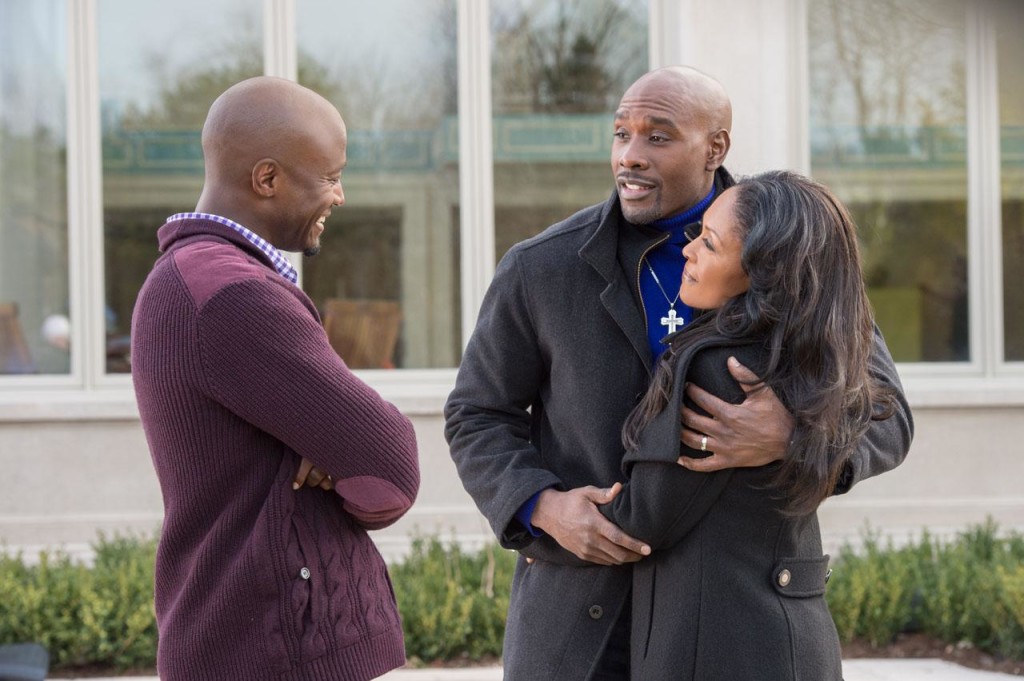Malcolm D. Lee’s “The Best Man Holiday” has all the trappings of a good film. The film achieves a satisfying balance between humor and drama, the characters have their fair share of troubles, and the actors involved are—for the most part—good at their craft, if not occasionally a little flat.
And, yet, “The Best Man Holiday” is never anything more than another feel-good holiday film with overt themes and blasé plot resolutions.
The movie is a sequel to Lee’s 1999 film “The Best Man,” which followed a group of friends navigating their relationships and identities on the verge of one of their weddings. The sequel starts with a quick montage, so viewers can see the character conflicts.

Taye Diggs, Morris Chestnut and Monica Calhoun fight the tension in “The Best Man Holiday,” the sequel to 1999’s “The Best Man.”
The first film culminates in the fracture of a friendship, after Lance (Morris Chestnut) finds out that his best friend Harper (Taye Diggs) slept with his soon-to-be-wife Mia (Monica Calhoun).
The new movie begins 15 years later, after the characters have settled down. To heal old wounds, Mia invited all of her old friends to her house for Christmas. Harper, the film’s quasi-protagonist, is a struggling writer on the verge of financial collapse. Lance has become an all-star player for the New York Giants and Harper accepts Mia’s invitation in the hopes of writing his old friend’s biography and getting a healthy chunk of cash from his publisher.
There are a number of side plots surrounding the other characters and, by the time everyone is in Mia and Lance’s mansion, old romances and unresolved conflicts are erupting at the dinner table. Unfortunately, there’s never a sense that things aren’t going to turn out all right, and this is ultimately what makes the film so unfulfilling; the inevitable resolution at the end of the film discourages the audience from feeling any real tension about the characters and their strife.
About halfway through the film, there’s a twist concerning Mia that serves as the most “tear-jerking” part of the plot, but it’s hard to take the moment seriously within the context of the story. As an audience, we almost expect the event and its conclusion as part of the “holiday drama” genre; it might make us cry, but it’s the shallowest sort of emotional manipulation we can expect.
The film is driven by some good acting throughout, however, particularly from Terrence Howard, who plays the incorrigible and irreverent Quentin. He delivers some of the movie’s best jokes and usually provides some comic relief during melodramatic scenes between the characters. His scenes with the other men—particularly when he fights with Julian (Harold Perrineau) in a car—are the film’s best, because these relationships end up feeling the most genuine.
The audience is expected to devote most of their emotional energy to the struggling reformation of Harper and Lance’s friendship. Unfortunately, Chestnut’s Lance is boring and flat for most of the film. It’s hard to believe that, after everyone else seems to have forgiven Harper, Lance is still harboring a grudge against his old friend. Moreover, his flat emotional transitions and overbearing religiousness make him exceedingly uninteresting.
If you’re the kind of moviegoer that’s just looking for a good bit of holiday nostalgia, you’ll probably find “The Best Man Holiday” to be worth your $10. But, if you’re looking for a film-going experience that will deliver something new and worthwhile, go ahead and save your money.
Sheldon may be reached at scosta@su-spectator.com








